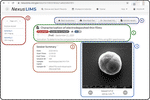Joshua Taillon
Materials Research Engineer
Research Software Engineer
Data Scientist and Solutions Architect
National Institute of Standards and Technology
Welcome!
Dr. Joshua Taillon is a staff scientist within the Office of Data and Informatics at the National Institute of Standards and Technology (Material Measurement Laboratory). He is an internationally recognized expert in scientific data management, real‑world data engineering solutions, scientific programming, and materials research. Since 2018, he has spearheaded efforts to modernize data management practices at NIST in diverse domains ranging from electron microscopy, to mechanical materials testing, to biosystems and biomaterials research. He has led technical development on a range of impactful projects, focusing on Laboratory Information Management (LIMS) and experimental metadata capture, including both backend systems and frontend interfaces. He has led federally‑funded working groups on advancing data management practices in materials research and is regularly invited to speak at both international and domestic scientific conferences.
Interests
- Scientific Data Management
- Scientific Programming
- Open Source Software
- Data Workflows and Schema Development
- Computational Microscopy
- Machine Learning for Materials
- Materials Characterization Research
Education
-
Ph.D. - Materials Science and Engineering, 2016
University of Maryland, College Park
-
M.S. - Materials Science and Engineering, 2014
University of Maryland, College Park
-
B.S. - Materials Science and Engineering, 2011
Cornell University










